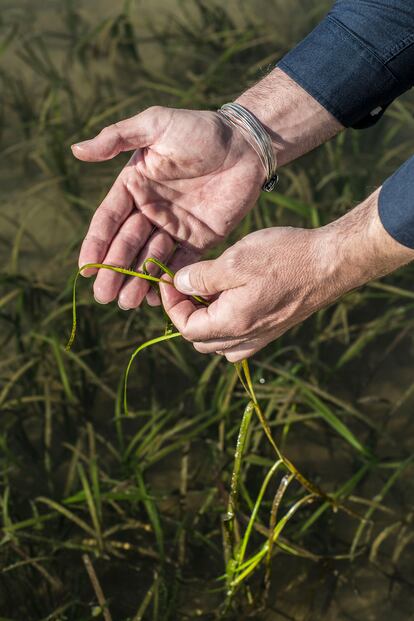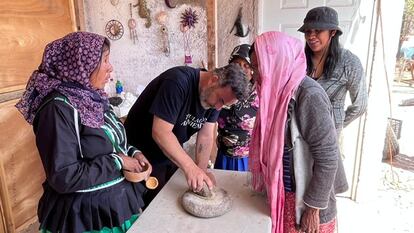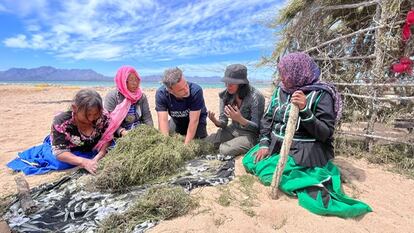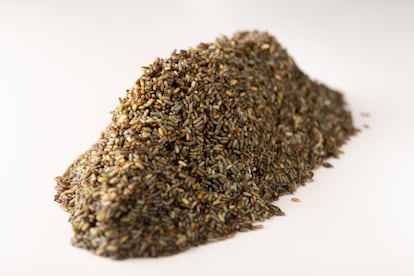‘Zostera marina,’ a Michelin-starred sea grain that could point to the future of hydroponic crops
Spanish chef Ángel León has worked with the Comcaac people of Mexico to cultivate the aquatic plant. ‘To generate food from the sea other than fish is the future of the oceans and of mankind’


Ángel León first noticed zostera marina while sailing in the Bay of Cádiz in Spain. “I saw something floating; it looked like an ear of wheat that had reached the sea. I picked it up, took it to the restaurant and they told me that it was a native plant in which cuttlefish and squid spawn, and that it is very important to the ecosystem of the seabed,” says the chef, who runs the three-Michelin star Aponiente restaurant in Puerto de Santa María. In 2021, after four years of research, he presented his discovery and began developing an ambitious project to produce what he baptized as “sea grain,” which he is increasingly closer to incorporating into his menu. “If all goes well, in two years it will be available at Aponiente all year round. I could already produce enough to last a month and a half, but until I have enough for a whole season, I will not put it on the menu,” he says. León has not been alone on his journey: in addition to his team of researchers, he has worked with the Comcaac people in Mexico, who shared their method of treating this marine plant, which is often called eelgrass.
The first step toward consistent production of sea grain was to find where the conditions are best for it to flourish. Last year, León announced that zostera marina seeds had been planted in seven different seas, all with different characteristics. Now, the best area for this aquatic crop has been determined. “Currently, we are focusing on Sonora, in Mexico, in a bay where there are almost 10,000 hectares of sea grain, which can provide a great pantry of knowledge regarding the treatment of this plant, because it is grows faster there than anywhere else in the world,” says León. “In other seas we have had many problems with turbidity; the plant drowns, the water is colder... that is why this is the best place.”
The chef traveled to Sonora at the beginning of the year to see how the Comcaac work with zostera marina, which is a traditional staple of their diet but whose use has gradually diminished over time. “They live in two villages located in the Sonora Desert, Punta Chueca and Desemboque, which Ángel visited and where the Aponiente team has been working, traveling there every year since 2021,″ Juan Martín, R&D and environment coordinator at Aponiente, tells EL PAÍS by email. “He has worked with them to recover the culture of xnoiss [the local name for zostera], to conserve the seagrass meadows in the Gulf of California and to improve the diet of their community.”

León describes the quality of zostera in this area of Mexico as “spectacular.” But it is not the only area in which he is experimenting with the cultivation of sea grain. In Cádiz, he has installed 3,000 square meters of experimental planting. “We have planted zostera from Galicia, Cantabria, Valencia, Cádiz and Alicante to see which is the most productive. This pilot project is a great base for the future of sea grain in Spain. It is a project that still needs time and a lot of investment.”
“This sea grain is a seed of a type of evolved aquatic plant called zostera marina, which years ago was terrestrial but evolved and began to grow in the sea and feed on water. It is one of the four types of marine phanerogams that exist and grow wild in Europe,” León and his team said in a 2021 report. Currently, six people, including three scientists, are researching this and other projects for Aponiente. “Biologists knew about it, without a doubt, but no one had attempted controlled experimental cultivation, which seeks to create seagrass meadows of zostera for consumption. We have created a network between Europe, the United States and Switzerland, with scientists who knew about the grain, but never thought that it could be extensively cultivated,” León explains.
León underlines his belief that the future lies in the sea, which for him “is the great unused pantry of mankind and also its pharmacy.” He believes that in the current climate of fresh water shortages and drought, it is necessary to look to the seas and promote the study of hydroponic crops. “We are going to be forced to do so, into the thinking that fresh water cannot provide the solution to everything. Irrigating crops with salt water is the real dream; to generate food from the sea other than fish is the future of the oceans and of mankind.”

How can zostera play a part, and what does it taste like? “It is a hybrid in flavor between rice and quinoa,” León says, adding that despite its origin, “it has no iodic or marine connotation.” He also highlights its properties: “It contains twice as many amino acids as rice and twice as much protein, it has vitamin B and D, it is gluten-free, it is the first grain to contain fatty acid… It has everything.” Experimenting in the kitchen, he has prepared it in different ways: “You can boil it and eat it as a bulgur or couscous, you can make bread, pasta or eat it as rice, with a cooking time of 16 minutes.” And León is already imagining the dishes he would like to incorporate into his menu: “I would like to make a classic Aponiente dish — rice with marine plankton — but in a 100% marine version, with zostera and plankton, a vegetable and a microalga. It would be like closing the circle of a dish where everything comes from the sea and with ingredients discovered by us.”
Despite the possibilities of zostera, León says he has received no interest or funding from the government. “We have opened a window to science and when you are doing something that no one else has done, it can be difficult. We live in a world where it may not be of interest to discover a crop in the sea, because it does not need antibiotics or fertilizers. Maybe in 15 or 20 years, human beings will be condemned to look to the sea because we will not be able to produce more protein from the land.”

In the meantime, he has found support from initiatives such as Moët & Chandon’s Toast for a Cause, which promotes environmental conservation and research into sustainability. “We have to preserve biodiversity; we wanted to connect with people from outside Champagne who have the same interests, and we met Ángel León and we support each other, because together we can work to make more progress,” says Benoît Gouez, chef de cave at the French winery.
Sign up for our weekly newsletter to get more English-language news coverage from EL PAÍS USA Edition
Tu suscripción se está usando en otro dispositivo
¿Quieres añadir otro usuario a tu suscripción?
Si continúas leyendo en este dispositivo, no se podrá leer en el otro.
FlechaTu suscripción se está usando en otro dispositivo y solo puedes acceder a EL PAÍS desde un dispositivo a la vez.
Si quieres compartir tu cuenta, cambia tu suscripción a la modalidad Premium, así podrás añadir otro usuario. Cada uno accederá con su propia cuenta de email, lo que os permitirá personalizar vuestra experiencia en EL PAÍS.
¿Tienes una suscripción de empresa? Accede aquí para contratar más cuentas.
En el caso de no saber quién está usando tu cuenta, te recomendamos cambiar tu contraseña aquí.
Si decides continuar compartiendo tu cuenta, este mensaje se mostrará en tu dispositivo y en el de la otra persona que está usando tu cuenta de forma indefinida, afectando a tu experiencia de lectura. Puedes consultar aquí los términos y condiciones de la suscripción digital.
More information
Archived In
Últimas noticias
Most viewed
- Sinaloa Cartel war is taking its toll on Los Chapitos
- Oona Chaplin: ‘I told James Cameron that I was living in a treehouse and starting a permaculture project with a friend’
- Reinhard Genzel, Nobel laureate in physics: ‘One-minute videos will never give you the truth’
- Why the price of coffee has skyrocketed: from Brazilian plantations to specialty coffee houses
- Silver prices are going crazy: This is what’s fueling the rally










































